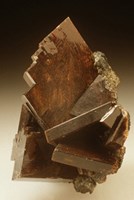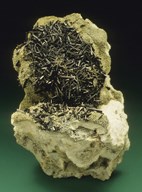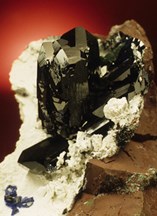HOW GOOD IS YOUR IMAGINATION? - Part 2
This is your final look how crystals are put together before the 2018 Show – Crystals & Crystal Forms. So, what have we learned thus far? We know there are six basic crystal systems – isometric, hexagonal, tetragonal, orthorhombic, monoclinic and triclinic. And we know that these designations are based on how the atoms in minerals fit together. The elemental atoms are arranged in a series of seed crystals whose interiors have imaginary lines, or axes, of different lengths. And that these axes meet at various angles in the center of the mineral’s seed. Like atoms attach to this seed and result in the macro crystals we see with our eyes. We’ve addressed the first three – isometric, hexagonal, tetragonal. Now let’s look at the remaining three – orthorhombic, monoclinic, triclinic.
Orthorhombic diagram
Let’s go to your imagination and visualize the orthorhombic crystal system. There are three axes that intersect at right angles, 90 degrees, in the center of the seed. The isometric and hexagonal systems we looked at earlier have a similar axis arrangement with axes of equal length. The difference here is that each axis is a different length. What might a mineral in the orthorhombic crystal system look like? You may see combinations of distorted octahedrons, pyramids and prisms. Some minerals that crystallize in this system include barite, sulfur and topaz. There are two models for you to cut out and assemble – an (click on) orthorhombic block and a (click on) basal orthorhomb.
Monoclinic diagram
The monoclinic crystal is next to consider. We still have three axes of different lengths compared to one another. Two of them cross at right, 90 degree, angles, while the third is perpendicular and at a 120 degree angle. Crystal shapes may resemble prismatic blocks like orthoclase feldspar or swords like gypsum. Other minerals that crystalize in the orthorhombic system include azurite, epidote and papagoite. To add to your crystal model collection we’ve provided a (click on) basal monoclinic model and an (click on) octapyramid.
Triclinic diagram
Lastly, there’s the triclinic crystal system. This one will really give your imagination a workout. There are only three axes, but they are all different lengths in relation to one another and they intersect at different and odd angles. There are only two subdivisions in this system, unlike the others with multiple subdivisions and classes. Basic shapes are prisms and pyramids but they are highly distorted. We’ve given you two models to assemble – an (click on) octahedron and a (click on) basal pyramid. Albite and microcline feldspars crystallize in the triclinic crystal system, as well as chalcanthite, manganbabbingtonite and turquoise.







